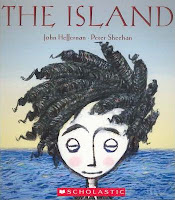Here are some things I believe:
When you plan to share books with a group of children:
You need to LOVE the book yourself
You need to simply let the students enjoy the book above all else
NOT every book needs to be analysed or overworked
MAKE EVERY book count
(And now I am going to add this)
I desperately hope that the purpose/joy/experience/delight/revelation/insight of reading picture books in classrooms and school libraries is not overshadowed by plans to "teach" specific English concepts, language conventions, visual literacy techniques, vocabulary, or comprehension strategies.
Quality Literature Recommendations - Stage One
This is a document from the NSW Department of Education. It contains books selected to support the implementation of the English K-2 Syllabus.
To identify the quality literature featured in this resource, we considered the following questions:
• Is the text widely regarded?
• Do either the images or the graphics extend and enrich the meaning?
• Does the text serve as a model text for students to compose their own text?
• Does the text offer a new insight, open different interpretations and reveal new understandings, provoking rich discussions?
• Does the text prompt critical and creative thinking and an emotional response?
• Does the text provide opportunity to explore new vocabulary?
• Is there figurative language? (for imaginative texts)
• Is there strong characterisation? (for imaginative texts)
• Is the plot or content interesting for my students?
• Does the text support achievement of outcomes?
• Does the structure of the text support learning?
In this post I will focus on the first concept from the list which is context. (Post edit - I have now also covered Narrative and Character).
The concepts in Stage 1 are: context, narrative, character, imagery, symbol and connotation, perspective and argument, and representation.
Identifying context (quoted from Quality Literature Recommendations)
To identify texts with the concept of ‘context’, look for texts that:
• explore social situations with language and actions appropriate to that situation
• depict situations which require specific language and behaviour
• reflect aspects of students’ world
• are composed for specific audiences and purposes
• compare the text forms and features through show how the communication of information and ideas varies
• demonstrate how different groups and cultures are represented.
Here are the suggested texts under the heading context (blue indicates a link to a review on my blog).
Boy by Phil Cummings illustrated by Shane DeVries - this book was a 2021 selection for the IBBY Outstanding books for Young People with Disabilties
Here is the Kirkus review for Boy. Here is a set of teachers notes from Scholastic.
Comparison text:
A Year on our Farm by Penny Matthews illustrated by Andrew McLean - this book was an IBBY Honour book.
Here are a set of teachers notes from Scholastic.
Comparison text:
One Photo by Ross Watkins illustrated by Liz Anelli
Comparison text:
Out by Angela May George illustrated by Owen Swan
Here are some teaching notes from Lamont.
Comparison texts:
Stolen Girl by Trina Saffioti illustrated by Norma MacDonald
Teaching notes from Reading Australia. Read this review in Kid's Book Review.
The obvious comparison text is The Burnt Stick but this book is most definitely NOT suitable for Stage One.
The Story about Ping by Marjorie Flack illustrated by Kurt Wise
This book was first published in 1933!
Comparison text:
The Treasure Box by Margaret Wild illustrated by Freya Blackwood
Teaching notes from Reading Australia. This is just my opinion but I would not share The Treasure Box with Stage One. I think this is a book for Middle and senior Primary classes.
Comparison text to use with Stage 3 would be The Angel with a Mouth Organ.
If you are not focusing on the Holocaust aspect of this book I would suggest a comparison text might be Tilly. I also recommend the book Favourite Memories.
Tom Tom by Rosemary Sullivan illustrated by Dee Huxley
Comparison texts:
Vanilla Ice cream by Bob Graham
Here is the Kirkus Star review.
Comparison text:
I am very happy to see this statement about reading the physical book - it is sad to hear how often teachers are making use of video versions as a way to share books with classes.
It is strongly recommended that these texts are read aloud to model effective reading and strengthen students’ personal engagement with texts.
The Early Stage One version of this document lists these books under the heading of Context and also suggests each of these are appropriate for Stage One:
All I want for Christmas is Rain by Cori Brooke illustrated by Megan Forward
Go Home, Cheeky Animals! by Johanna Bell illustrated by Dion Beasley
I'm Australian Too by Mem Fox illustrated by Ronojoy Ghosh
Nannie Loves by Kylie Dunstan
The Patchwork Bike by Maxine Beneba Clarke illustrated by Vann T Rudd
If this post generates some comments I might go on to explore the other six concepts.















2 comments:
As always your comments and suggestions are spot on and so valuable and relevant.
Thank you for this post. As a lover of literature, most especially picture books, your blog and this post, is helping me stay focused on the topic rather than being constantly distracted by the next beautiful picture book I see.
Post a Comment